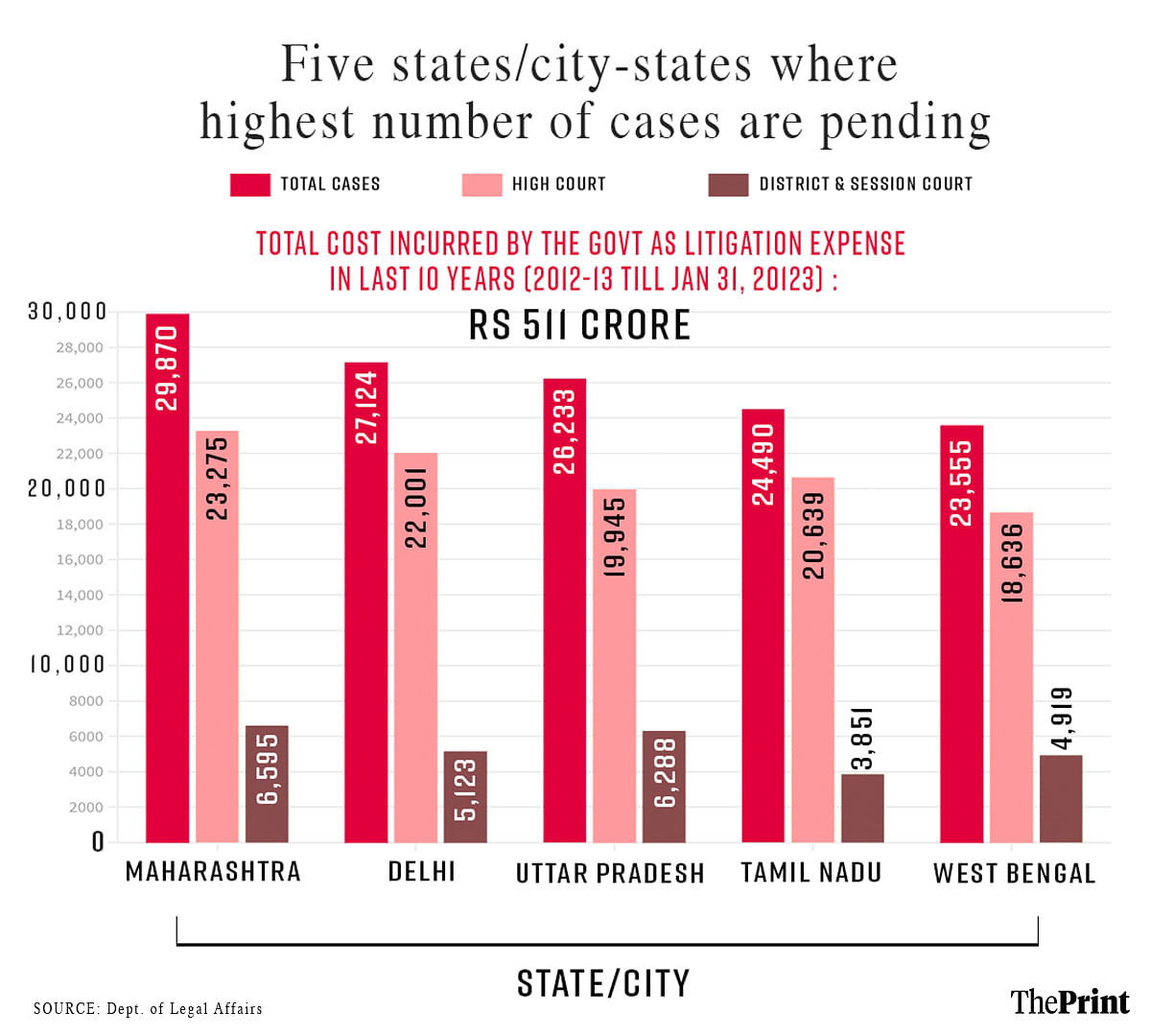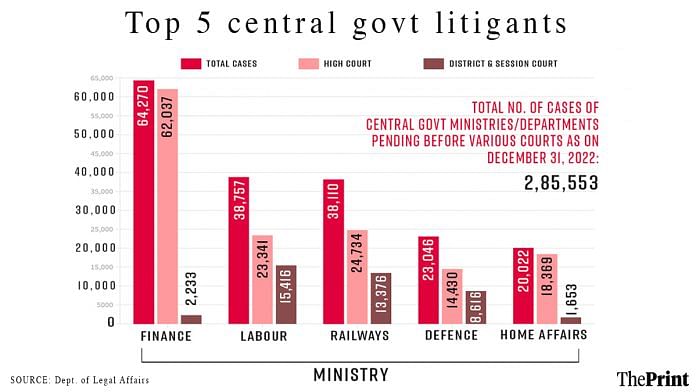New Delhi: The Union finance ministry is the biggest litigant among central ministries followed by labour and railways, the ministry of law and justice has informed a parliamentary panel last week, ThePrint has learnt.
While 64,270 cases of the finance ministry are pending in different high courts, district and session courts as on 31 December, 2022, the labour and employment ministry has 38,757 cases pending while the railways are a close third with 38,110.
The other ministries with a high number of pending cases include defence (23,046), home (20,022), consumer affairs, food and public distribution 15,766 and education 12,762.
Overall, 57 central ministries and departments have 2,85,553 cases pending in high courts, district and sessions courts. In the past 10 years (2012-2013 till 31 January, 2023), the government incurred Rs 511.1 crore as litigation expense for payment of legal fees to government advocates/panel counsels in various courts and tribunals.
These figures are part of the response shared by the Department of Legal Affairs, which comes under the law ministry, with the parliamentary standing committee on personnel, public grievances, law and justice. The parliamentary panel was examining the Demands for Grants of the ministry for the expenditure it will be incurring in the 2023-24 fiscal.
Legal experts told ThePrint that the number of cases could be far higher as it does not include the cases of ministries pending before the Supreme Court. To be sure, the government may not be a petitioner in all these cases, but in several could be a respondent party — one against whom a case is filed.
Of the total 2.85 lakh cases that are pending, 2,27,444 are with the high courts and 58,109 in the district and session courts. The maximum cases are pending in high courts/district and session courts in Maharashtra (29,870) followed by Delhi (27,124), Uttar Pradesh (26,233), Tamil Nadu (24,490) and West Bengal (23,555).

Non-performance of various wings of the executive and legislature has been cited as the reason for the government being the biggest litigants, accounting for nearly 50 per cent of the over 4 crore cases pending in various courts. Aware of its contribution towards the high litigation numbers, the Centre has come up with a National Litigation Policy to reduce the government’s share.
However, the results are not very promising with both Centre and states being regularly criticised for not doing enough to bring down its litigation.
Prime Minister Narendra Modi, too, has called to “lessen the load on the judiciary,” which, he said, spends its maximum time in hearing cases where the government is a party. He too felt that cases should be filed after taking a considered view.
Also Read: ‘Why we hear routine matters…,’ SC explains, 2 days after law minister pointed out backlog
Judiciary flagged issue several times
Such a large number of pending cases is a cause of major concern with even the highest echelons of the judiciary, including former chief justices of India, highlighting it in public platforms.
At the inaugural session of the joint conference of chief ministers and chief justices of high courts last year, the then Chief Justice of India (CJI) N.V. Ramana complained that no government action on court decisions has resulted in addition of contempt petitions in courts, increasing the burden on judges. Justice Ramana called it deliberate inactions on the part of government departments on court orders, which, he warned, were not good for “the health of democracy.”
He blamed the “non-performing executives” as one of the causes for rising caseload, apart from ambiguities in laws and low judge-population ratio of 20 judges per 10 lakh people.
Later, addressing the ISB Leadership Summit in September 2022, he said that half of the judiciary’s problems will be resolved if it decides to put a halt to state-sponsored litigations.
Another former CJI T.S. Thakur also voiced his concern over the issue when in office. Prior to his taking over the CJI’s post, he criticised both central and state governments for being the “biggest litigant”, saying that a large number of cases pending against it was “not a good sign of good governance”. He urged the government to be “responsive to prevent cases coming to the courts”.
Later, as Thakur lamented that while the load of government cases remained high, the latter did little to increase the sanctioned strength of judges from 21,000 to 40,000 to reduce the burden on the overworked judiciary.
Even after his retirement, he asked the government to address the issue and decide in an objective manner the cases which are to be contested up to the SC. The former CJI was of the view that as no officer is ready to take a decision on which case merits an appeal, petitions were filed being casually in higher courts against lower court orders. He said officers were afraid to take any objective decision as they are apprehensive that their decisions may be questioned later.
Senior advocate Ajit Kumar Sinha, who has represented many states in the top court, said despite introducing measures to reduce litigation, both central government and states have failed to put it to optimal use because their officers are “bereft of any will to actually act towards it.”
The government, he added, never distinguishes between genuine, routine and deliberate filing of cases. “Each ministry should have a committee to determine if a matter requires to be contested or not. There are cases that can be settled at the pre-litigation stage itself, through imposing a minor penalty or compounding an offence,” Sinha said.
According to him, close to 20 per cent of the total government litigation includes delayed appeals that are filed beyond the deadline period. “Most of such appeals are filed for the purpose of putting it on record by the concerned department and all of them get dismissed for violating the limitation period.”
Another measure that could address the problem is compilation of matters where the question of law involved is common. “There are many cases that deal with the same legal issue. The government should compile all these cases and get them clubbed by the top court so that they are settled through a common order,” Sinha explained.
(Edited by Tony Rai)
Also Read: 16 yrs of tareekh pe tareekh & a ‘victory’ after death — court staffer’s long fight for justice



